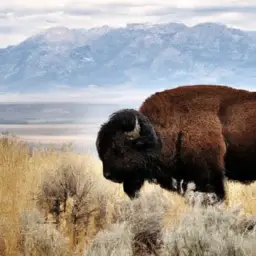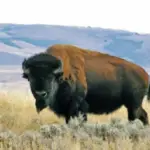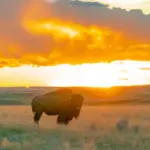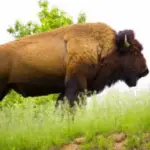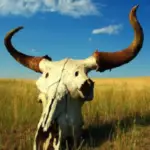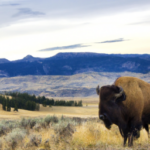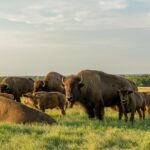You’re in for a wild adventure as we take you to Antelope Island, a stunning natural habitat that houses a majestic herd of bison. With rolling plains and breathtaking landscapes, this island boasts a unique opportunity for wildlife enthusiasts to witness the sheer beauty and awe-inspiring presence of these magnificent creatures. In this article, we will uncover the long-standing mystery of exactly how many bison call Antelope Island their home, providing fascinating insights into the population and conservation efforts surrounding these iconic animals. Get ready to explore the untamed wilderness and discover the secrets of this incredible island sanctuary.
History of Bison on Antelope Island
Origination of Bison on the Island
The history of bison on Antelope Island can be traced back to the late 19th century when a small herd was brought to the island as part of an effort to establish a population of bison in the region. The bison were originally transported from the Yellowstone National Park, where they were facing the threat of extinction due to unregulated hunting and habitat loss. These majestic creatures were introduced to Antelope Island in the hopes of preserving their species and providing an opportunity for the public to appreciate their beauty and importance to the ecosystem.
Evolution Over the Years
Since their introduction, the bison population on Antelope Island has experienced both challenges and successes. Initially, the herd struggled to adapt to the island’s unique environment, resulting in a decline in population. However, over time, the bison demonstrated remarkable resilience and successfully adapted to the island’s climate and available resources. This led to a resurgence in their population, which has continued to grow steadily over the years.
Notable Historical Events
Throughout history, the bison on Antelope Island have witnessed and played a role in several significant events. One such event was the establishment of Antelope Island State Park in 1969, which aimed to protect the island’s natural resources, including the bison population. Additionally, the park has been involved in various conservation initiatives, including the implementation of measures to ensure the long-term sustainability of the bison herd. These efforts have helped shape the history of the bison on Antelope Island and have contributed to their continued presence on the island today.
Bison Population: A General Overview
Current Population
As of the most recent survey conducted by park authorities, the bison population on Antelope Island stands at approximately 700 individuals. This represents a significant increase from the initial introduction of bison to the island and demonstrates the success of conservation efforts in maintaining a stable and healthy population.
Increase or Decrease Over Time
Over the years, the bison population on Antelope Island has witnessed fluctuations in numbers. Initially, the population struggled to establish itself, leading to a decrease in numbers. However, with the implementation of conservation measures and enhanced management strategies, the population has steadily increased and is now thriving. The current population stands as a testament to the successful management of the bison on Antelope Island.
Factors Influencing Population
Several factors play a role in influencing the population dynamics of the bison on Antelope Island. One of the primary factors is the availability of suitable habitat and resources. The island’s unique ecosystem, consisting of grasslands and shrublands, provides an ample food source for the bison throughout the year. Additionally, the absence of natural predators on the island allows the bison population to grow without significant predation pressure. However, park management closely monitors the population size to ensure that it remains in balance with the available resources to prevent overgrazing and maintain the overall health of the ecosystem.
Impact of Bison on Antelope Island’s Ecosystem
Role of Bison in the Island’s Ecosystem
Bison play a crucial role in maintaining the balance of the island’s ecosystem. As large herbivores, they help regulate plant growth through grazing, which promotes the growth of diverse plant species and prevents the dominance of any one plant type. Their grazing habits also contribute to the creation of open areas, which are crucial for the survival of certain plant species and the overall functioning of the ecosystem. Additionally, through their feeding activities, bison aid in nutrient cycling, as their dung acts as a fertilizer, enhancing soil fertility.
Impact on Other Wildlife
The presence of bison on Antelope Island has a significant impact on other wildlife species. Bison create and maintain habitats that are beneficial to a variety of bird species, as they disturb the soil and facilitate the growth of plants that these birds depend on for nesting and foraging. Furthermore, several smaller animals, such as rodents and insects, benefit from the bison’s grazing activities, as they feed on the grasses and other vegetation that bison have trimmed. In this way, the bison indirectly support a diverse array of wildlife on the island.
Impact on Vegetation
While bison contribute to the overall health and diversity of the vegetation on Antelope Island, they can also have localized impacts on specific plant communities. Their feeding patterns and trampling behaviors can result in distinct patches of vegetation being grazed more heavily than others. However, these disturbances are part of a natural process and ultimately lead to increased plant diversity and the maintenance of a mosaic of plant communities across the island.
Bison Management and Conservation Efforts
Role of Park Management
The management of the bison population on Antelope Island is a collaborative effort involving park authorities, conservation organizations, and scientific experts. Park management plays a vital role in monitoring the population size, ensuring the availability of suitable habitat and resources, and implementing strategies to maintain a healthy and sustainable bison population. They closely collaborate with researchers to gather data on population dynamics, behavior, and health, which informs management decisions and helps develop effective conservation strategies.
Conservation Strategies
To ensure the long-term conservation of the bison on Antelope Island, various strategies have been implemented. These include regular monitoring of the population size and health, as well as the establishment of a comprehensive management plan that guides the sustainable management of the herd. Additionally, genetic diversity is closely monitored and maintained to prevent inbreeding and maintain a healthy and resilient population. The management team also collaborates with neighboring wildlife authorities to exchange knowledge and best practices in bison conservation.
Challenges and Successes
The management of the bison population on Antelope Island is not without its challenges. The island’s limited land area presents a challenge in maintaining a balance between the bison population and the available resources. Park management continuously monitors the grazing patterns and adjusts the population size accordingly to prevent overgrazing and ensure the overall health of the ecosystem. Despite these challenges, the conservation efforts have been largely successful, as evidenced by the steady growth of the bison population and the positive impact on the island’s ecosystem.
Annual Bison Roundup
Purpose of the Roundup
The annual bison roundup is a significant event that serves several important purposes. Firstly, it allows park authorities to assess the overall health and condition of the bison herd. This includes monitoring for any signs of disease, checking body condition, and tagging individuals for identification purposes. Additionally, the roundup helps maintain the desired population size by selectively removing certain individuals from the herd. This contributes to preventing overpopulation and ensures that the available resources are efficiently utilized by the bison.
Logistics of the Event
The annual bison roundup is a meticulously planned event that involves the coordination of numerous personnel, equipment, and resources. Park rangers, veterinarians, and volunteers work together to safely corral the bison into temporary holding pens, where they can be individually inspected, treated if necessary, and selected for removal based on predetermined criteria. The roundup takes place over a period of several days to allow for a thorough assessment of the entire herd, ensuring that no individual bison is overlooked.
Community Involvement
The annual bison roundup on Antelope Island has garnered significant community involvement and support. It offers an opportunity for interested individuals to actively participate in the conservation efforts and gain insight into the management of the bison population. Local volunteers provide invaluable assistance during the event, helping with various tasks such as herding, data collection, and logistical support. The community’s involvement not only strengthens the bond between the park and its visitors but also fosters a sense of ownership and responsibility for the conservation of the bison and the island’s ecosystem.
Tourism and Public Interaction with Bison
Tourism Statistics
The presence of the bison on Antelope Island has greatly contributed to the island’s tourism industry. Every year, thousands of visitors flock to the island to witness these magnificent animals in their natural habitat. The bison have become a major attraction, drawing tourists from all over the world who are eager to experience the unique wildlife and scenery that Antelope Island offers. The tourism industry on the island has thrived, providing economic benefits to local businesses and communities.
Guidelines for Safe Interaction
While tourism contributes significantly to the local economy, it is important to ensure that the interactions between visitors and the bison are safe for both parties involved. Park authorities have implemented guidelines to educate visitors on the proper etiquette and behavior around the bison. Visitors are encouraged to maintain a safe distance, never approach or attempt to feed the animals, and avoid any sudden movements that may startle them. By following these guidelines, visitors can enjoy a memorable and responsible experience while minimizing any potential disturbance to the bison and their habitat.
Impact of Tourism on Bison
The influx of tourists on Antelope Island inevitably has an impact on the bison population. While the guidelines in place aim to minimize any negative effects, the increased human presence can still disrupt the natural behavior and habitat use of the bison. Park management closely monitors the impact of tourism on the bison and continuously evaluates the effectiveness of the guidelines to ensure the well-being and conservation of the population. The collaboration between park authorities and tourism stakeholders is essential in striking a balance between visitor enjoyment and the preservation of the island’s wildlife.
Bison Health and Disease Management
Common Health Issues
The health of the bison population on Antelope Island is a crucial aspect of their overall well-being and long-term sustainability. While the population has generally remained healthy, there are certain health issues that park authorities vigilantly monitor and manage. One of the common concerns is parasitic infestations, such as ticks and lice, which can negatively impact the bison’s physical condition and compromise their health. Additionally, respiratory infections and injuries resulting from aggressive interactions within the herd can occur, requiring prompt veterinary intervention.
Disease Management Programs
To ensure the health and well-being of the bison, the park management has implemented comprehensive disease management programs. Regular health checks and assessments are conducted, allowing for the early detection and treatment of any potential health issues. Vaccinations are also administered to prevent the spread of infectious diseases within the herd. Moreover, the bison are regularly monitored for any signs of emerging diseases or outbreaks, enabling swift containment and mitigation measures to be implemented.
Role of Veterinary Care
Veterinary care plays a crucial role in maintaining the health and welfare of the bison on Antelope Island. Experienced veterinarians are involved in routine health checks, disease monitoring, and the treatment of any injuries or illnesses that may arise. Their expertise and dedication ensure that the bison receive the necessary care and attention to maximize their chances of survival and overall well-being. The veterinary team also collaborates with research institutions to stay informed about the latest advancements in bison health management, ensuring the application of best practices.
Impacts of Climate Change on Bison Population
Effects of Climate Change
Climate change poses significant challenges to the bison population on Antelope Island. Rising temperatures, altered precipitation patterns, and changing vegetation dynamics directly impact the availability and quality of food resources for the bison. These changes can lead to shifts in the distribution of suitable habitats, affecting the bison’s spatial behavior and potentially limiting their access to key resources. Additionally, climate change can increase the prevalence and transmission of certain infectious diseases, further threatening the health and survival of the population.
Adaptation Strategies
In response to the challenges posed by climate change, park management has implemented various adaptation strategies to ensure the resilience of the bison population. This includes monitoring the vegetation dynamics and making proactive habitat management decisions to enhance resilience and promote the survival of the bison. Additionally, ongoing research and collaboration with scientific experts help identify and implement adaptive measures that will enable the bison to thrive in a changing climate. By staying proactive and adaptable, park management endeavors to secure the long-term viability of the bison on Antelope Island.
Future Predictions
The future of the bison population on Antelope Island is uncertain due to the uncertainties surrounding climate change. However, scientists and management authorities predict that if effective adaptation strategies are in place, the bison population can adapt and continue to thrive. These strategies, coupled with ongoing research and monitoring, provide valuable insights that will inform decision-making and help mitigate potential threats. With careful management and conservation efforts, there is reason to remain optimistic about the future of the bison on Antelope Island.
Research and Scientific Studies on the Bison
Ongoing Research Topics
Research and scientific studies are essential tools in understanding and managing the bison population on Antelope Island. Ongoing research focuses on various topics, including the bison’s behavior and social structure, their habitat preferences, reproductive patterns, and genetic diversity. Additionally, studies are being conducted to assess the impact of bison grazing on vegetation dynamics, as well as the interactions between the bison and other wildlife species. These research efforts provide valuable insights into the ecology and conservation of the bison population and guide management decisions.
Key Findings
Research conducted on the bison population on Antelope Island has yielded significant key findings. Studies have revealed that the bison employ a variety of strategies to cope with the island’s unique environment, demonstrating their adaptability and resilience. Additionally, research has shown that the bison play a crucial role in maintaining the island’s biodiversity through their grazing activities. Key findings have also emphasized the importance of genetic diversity in ensuring the long-term viability of the population and have highlighted the need for continued genetic monitoring and management.
Implications for Bison Management
The findings from research and scientific studies have important implications for the management of the bison population on Antelope Island. They inform decision-making processes, guide conservation strategies, and help identify areas of concern that require attention. For example, understanding the bison’s habitat preferences allows park management to make informed decisions regarding habitat management and allocation of resources. Additionally, knowledge about genetic diversity and social dynamics guides breeding programs and prevents the loss of genetic variation within the population. The ongoing collaboration between researchers and park management ensures that scientific knowledge is translated into effective management practices.
Is Antelope Island a Popular Location for Bison Herds?
Yes, Antelope Island is a popular location for bison herds. The island, located in Utah, is home to a large population of bison and is considered to be the state with the most bison population. Visitors can observe these majestic animals in their natural habitat while enjoying the stunning scenery of the island.
Future of Bison on Antelope Island
Projected Population Growth
The future of the bison population on Antelope Island looks promising, with projected population growth anticipated. The successful management and conservation efforts have resulted in a steady increase in population size, and as long as the current strategies remain in place, the population is expected to continue to grow. Monitoring and adaptive management practices will play a crucial role in ensuring that the population remains at sustainable levels, balancing the availability of resources with the needs of the bison.
Potential Impacts on Island Ecosystem
The expanding bison population on Antelope Island may have potential impacts on the island’s ecosystem. As the population grows, the grazing pressure on vegetation and the creation of open areas may become more pronounced. It is imperative that park management maintains a delicate balance to ensure the sustainability of both the bison population and the overall health and diversity of the ecosystem. Ongoing research and adaptive management strategies will be critical in understanding and mitigating any potential negative impacts.
Conservation Goals
The future of the bison on Antelope Island is intertwined with the conservation goals set by park management and conservation organizations. These goals encompass maintaining a genetically diverse and healthy population, preserving the island’s unique ecosystem, and ensuring a sustainable balance between the bison population and available resources. The conservation efforts will continue to focus on adaptive management, scientific research, and community involvement to foster a deep appreciation and commitment to the preservation of Antelope Island’s bison and their habitat.
In conclusion, the history of bison on Antelope Island is enigmatic and captivating. From their origination and challenges to their remarkable adaptation and population growth, the bison have become an integral part of the island’s ecosystem. The Antelope Island State Park’s dedicated management and conservation strategies have ensured the long-term survival and well-being of the bison, with the annual roundup providing a valuable opportunity for assessment and population management. The interaction between tourism and the bison population, along with the rigorous health and disease management programs, further shape the current state of the bison on the island. Climate change poses new challenges and calls for adaptation strategies, while ongoing research provides key insights for effective management decisions. Regardless of the uncertainties, the future projection looks promising, as long as the conservation goals are met and the delicate balance between the bison population and the island’s ecosystem is maintained. The bison’s legacy on Antelope Island is one of resilience, harmonious coexistence, and a testament to the value of conservation efforts in preserving our natural heritage.

